An In-Orbit Measurement Method for Elevation Antenna Pattern of MEO Synthetic Aperture Radar Based on Nano Calibration Satellite
Abstract
:1. Introduction
- (a)
- Ground receiver method [6,7,8,9,10]. Several ground receivers are deployed in the SAR swaths area along the range direction with certain intervals. Each receiver measures the amplitude of the pulses transmitted by the SAR satellite during an overflight and records the precise time of pulse sampling at the same time. The data recorded by multiple receivers distributed in the range direction can be processed to obtain the elevation antenna pattern. However, multiple ground instruments are required in the case of a wide swath, and thus the workload and cost are very high;
- (b)
- Tropical rainforest method [4,11]. The Amazon tropical rainforest is a quite homogeneous scatterer, and thus the shape of the SAR elevation antenna pattern can be clearly visible in the SAR raw data. In order to obtain an accurate two-way elevation antenna pattern, all azimuth lines are summed up and each pixel position is transformed as a function of the elevation angle, through which, the shape of the SAR elevation antenna pattern can be obtained. Due to the restrictions of disturbing areas, the typical width of the Amazon tropical forest area that can be used for calibration is approximately 150 km;
- (c)
- Antenna model method [12,13,14,15,16]. During the 21st century, an active phased array antenna has been widely deployed on spaceborne SAR due to its flexibility in beam forming. As the number of antenna beams increased, the German Aerospace Center (DLR) developed the antenna model method, which derives the antenna patterns from mathematical models in combination with the tropical rainforest method. The application of such an antenna model method has been successfully demonstrated for the TerraSAR-X mission. However, ground-based methods are still required for the verification of the antenna patterns.
2. Materials and Methods
2.1. Measuring Principle of The Space-Based Method
2.2. Orbit Design of The Nano Calibration Satellite
2.3. Error Factors of the Space-Based Method
- Different measuring duration. Measuring time of the ground receiver method depends on the synthetic aperture time. In this space-based method, the measuring duration of the elevation antenna pattern is mainly determined by the range of and the velocity component of the calibration satellite along the range direction, which is much longer compared to the ground-based method;
- Different motion of receiver. The ground receivers are deployed on the calibration site with fixed location measured by ground GPS devices, and the receiver antenna is precisely pointing to the SAR satellite according to local incident angle. However, the receiver mounted on the CAL is always in motion during the crossing time, and the antenna pointing is adjusted before each measurement and will not change during the crossing time;
- Different measuring environment. Since the ground receivers are deployed on the ground calibration sites, the background clutter may affect the antenna pattern measurement results. However, the measuring environment of the CAL receiver is in space, and the influence of the background clutter can be ignored.
- SAR transmitting power stability : As the measurement time elapses, SAR transmitting power changes due to the temperature drift of SAR instrument, which can directly affect the amplitude of the SAR signal and the antenna pattern measurement. Due to the longer measurement duration compared with the ground receiver method, the influence of the SAR transmitting power stability on each sampling point should be taken into consideration in this space-based method. The characteristics of SAR transmitting power stability can be measured and corrected through SAR internal calibration. Therefore, in the subsequent simulation, the SAR transmitting power stability can refer to the internal calibration accuracy;
- The receiver channel gain stability : Low amplitude variation of the receiving power is important for the elevation antenna pattern measurement, and the module that mainly affects the channel gain in the receiver is the low noise amplifier (LNA). Similar to the SAR transmitting power stability, the receiver channel gain stability (i.e., the gain stability of the LNA) is affected by the temperature drift as well, and the receiver channel gain calibration is required to reduce the influence of its impact on the antenna pattern measurement;
- SAR-to-CAL range measurement error : The MEO-SAR and CAL use GPS units to achieve precise orbit determination. The SAR-to-CAL slant range measurement error is introduced by the GPS orbit determination errors (random error). Although less accurate than position determination of ground receiver, the ratio of slant range measurement error is very small and the resulting error can be ignored due to the large difference in orbit altitudes between the CAL and the MEO-SAR;
- MEO-SAR antenna pointing error: The MEO-SAR satellites use star sensors to determine the satellite’s three-axis attitude. The MEO-SAR attitude errors can lead to antenna pointing errors ( in elevation and in azimuth) and are mainly composed of the systematic bias (due to errors in the sensor installation) and the random measurement error (related to the measurement accuracy of the star sensors);
- CAL receiver antenna pointing error: In order to reduce costs and power consumption, nano calibration satellites generally use sun sensors or gyroscopes to determine three-axis attitudes (lower accuracy compared with the star sensor). Similarly, the CAL attitude errors can lead to CAL receiver antenna pointing errors ( and ), which can cause the CAL receiver antenna gain error. In addition, the pointing of the receiver antenna continuously changes with the movement of the CAL. Therefore, the 3 dB beam-width of the antenna should be wide enough (not less than 20 deg), and so pointing accuracy and stability requirements are not too rigorous;
- The signal-to-noise ratio (SNR): Since the ground receivers are deployed on the ground calibration sites, the background clutter may affect the signal-to-noise ratio, which, in turn, affects antenna pattern measurement results. Therefore, appropriate calibration sites must be considered to improve the SNR and reduce the influence of the background clutter on the antenna pattern measurement. However, the measuring environment of the CAL receiver is in space, and the measurement error caused by the signal-to-noise ratio can be ignored.
3. Results and Analysis
3.1. Simulation Process
- (1)
- With the given orbital elements of the MEO-SAR and the orbit altitude of the CAL, calculate the inclination of the CAL through the orbit design method in Section 2;
- (2)
- With the known orbital elements of the MEO-SAR and the CAL, create a scenario containing the MEO-SAR and the CAL through Satellite Tool Kit (STK);
- (3)
- With the current MEO-SAR beam parameters, include the boresight and elevation beamwidth, and calculate the beam-to-CAL visibility (include visible start time, stop time and duration) in the analysis period of the scenario through STK;
- (4)
- Export the coordinates and velocity of the MEO-SAR and the CAL in the inertial coordinate system of each beam-to-CAL visible opportunity at a fixed time step size through STK;
- (5)
- With the known coordinates and velocity of the MEO-SAR and the CAL, calculate the azimuth angle, elevation angle and the SAR-to-CAL slant range at each sampling point during the crossing time of each beam-to-CAL visible opportunity considering the system parameters and the imaging geometry;
- (6)
- To screen the calibration opportunity from all visible opportunities, the following condition is applied: for each visible opportunity, if its range of elevation angle can cover the current SAR beam’s elevation beamwidth, this opportunity can be regarded as a calibration opportunity for antenna pattern measurement;
- (7)
- Derive the reference elevation antenna pattern from the given MEO-SAR antenna pattern model;
- (8)
- With the given MEO-SAR antenna pattern model, the calculated results in (5) and the system parameters, based on Equation (8), the measured MEO-SAR signal power (in dB) received by the CAL receiver of each sampling point can be calculated by introducing the error factors analyzed in Section 2.3. Based on the data processing steps in Figure 2, the normalized sampling data profiles of the elevation antenna pattern can be calculated and the fit of the sampling data profiles can be obtained through polynomial curve fitting;
- (9)
- Compare the measured antenna pattern data profiles calculated in (8) with the reference antenna pattern obtained in (7) and calculate the difference between them. Then, the fit of the difference can be obtained through polynomial curve fitting.
3.2. Simulation Parameters and Error Factors
3.3. Obit Design Validation
3.4. Method Accuracy Verification
4. Discussion
5. Conclusions
Author Contributions
Funding
Institutional Review Board Statement
Informed Consent Statement
Data Availability Statement
Conflicts of Interest
References
- Matar, J.; Rodriguez-Cassola, M.; Krieger, G.; López-Dekker, P.; Moreira, A. MEO SAR: System Concepts and Analysis. IEEE Trans. Geosci. Remote. Sens. 2020, 58, 1313–1324. [Google Scholar] [CrossRef] [Green Version]
- Matar, J.; Rodriguez-Cassola, M. Mission Considerations for Future MEO SAR Systems. In Proceedings of the 12th European Conference on Synthetic Aperture Radar, EUSAR 2018, Aachen, Germany, 4–7 June 2018; pp. 1–5. [Google Scholar]
- Freeman, A. SAR CALIBRATION-AN OVERVIEW. IEEE Trans. Geosci. Remote. Sens. 1992, 30, 1107–1121. [Google Scholar] [CrossRef]
- Shimada, M.; Freeman, A. A technique for measurement of spaceborne SAR antenna patterns using distributed targets. IEEE Trans. Geosci. Remote. Sens. 1995, 33, 100–114. [Google Scholar] [CrossRef]
- Seifert, P.; Lentz, H.; Zink, M.; Heel, F. Ground-based measurements of inflight antenna patterns for imaging radar systems. IEEE Trans. Geosci. Remote. Sens. 1992, 30, 1131–1136. [Google Scholar] [CrossRef]
- Lukowski, T.; Hawkins, R.; Cloutier, C.; Wolfe, J.; Teany, L.; Srivastava, S.; Banik, B.; Jha, R.; Adamovic, M. RADARSAT elevation antenna pattern determination. In Proceedings of the 1997 IEEE International Geoscience and Remote Sensing Symposium Proceedings, Remote Sensing—A Scientific Vision for Sustainable Development, IGARSS’97, Singapore, 3–8 August 1997; Volume 3, pp. 1382–1384. [Google Scholar]
- Seifert, P. ERS-1 Preliminary Antenna Elevation Pattern Measured by Ground-Receivers; ESA: Paris, France, 1993; pp. 157–159. [Google Scholar]
- Thompson, A.; Racine, D.; Luscombe, A. RADARSAT-2 antenna calibration using Ground Receivers/Transmitters. In Proceedings of the IEEE International Geoscience and Remote Sensing Symposium, Toronto, ON, Canada, 24–28 June 2002; Volume 3, pp. 1465–1467. [Google Scholar]
- Lenz, R.; Pontes, J.; Wiesbeck, W. A high accuracy calibration and receive instrument for TerraSAR-X ground calibration. In Proceedings of the European Radar Conference, EURAD 2005, London, UK, 6–7 October 2005; pp. 411–414. [Google Scholar]
- Lenz, R.; Pontes, J.; Wiesbeck, W. The TerraSAR-X ground calibration system and pattern estimation software. In Proceedings of the 2005 IEEE International Geoscience and Remote Sensing Symposium, IGARSS ’05, Seoul, Korea, 29 July 2005; Volume 7, pp. 4894–4897. [Google Scholar]
- Fang, Y.; Moore, R. Inflight vertical antenna patterns for SIR-C from Amazon rain-forest observations. In Proceedings of the IGARSS ’96, 1996 International Geoscience and Remote Sensing Symposium, Lincoln, NE, USA, 31 May 1996; Volume 1, pp. 496–498. [Google Scholar]
- Schwerdt, M.; Brautigam, B.; Bachmann, M.; Doring, B.; Schrank, D.; Hueso Gonzalez, J. Final TerraSAR-X Calibration Results Based on Novel Efficient Methods. IEEE Trans. Geosci. Remote. Sens. 2010, 48, 677–689. [Google Scholar] [CrossRef]
- Bachmann, M.; Schwerdt, M.; Brautigam, B. TerraSAR-X Antenna Calibration and Monitoring Based on a Precise Antenna Model. IEEE Trans. Geosci. Remote. Sens. 2010, 48, 690–701. [Google Scholar] [CrossRef]
- Brautigam, B.; Schwerdt, M.; Bachmann, M. An Efficient Method for Performance Monitoring of Active Phased Array Antennas. IEEE Trans. Geosci. Remote. Sens. 2009, 47, 1236–1243. [Google Scholar] [CrossRef] [Green Version]
- Reimann, J.; Schwerdt, M.; Schmidt, K.; Ramon, N.T.; Döring, B. The DLR Spaceborne SAR Calibration Center. Frequenz 2017, 71, 619–627. [Google Scholar] [CrossRef]
- Schwerdt, M.; Schmidt, K.; Tous Ramon, N.; Klenk, P.; Yague-Martinez, N.; Prats-Iraola, P.; Zink, M.; Geudtner, D. Independent System Calibration of Sentinel-1B. Remote. Sens. 2017, 9, 511. [Google Scholar] [CrossRef] [Green Version]
- Edelstein, W.; Madsen, S.; Moussessian, A.; Chen, C. Concepts and Technologies for Synthetic Aperture Radar from MEO and Geosynchronous orbits. In Proceedings of the SPIE—The International Society for Optical Engineering, San Diego, CA, USA, 30 September 2005. [Google Scholar]
- Guccione, P.; Scagliola, M.; Giudici, D. Low-Frequency SAR Radiometric Calibration and Antenna Pattern Estimation by Using Stable Point Targets. IEEE Trans. Geosci. Remote. Sens. 2018, 56, 635–646. [Google Scholar] [CrossRef]
- Prosser, R. The Lincoln calibration sphere. Proc. IEEE 1965, 53, 1672–1673. [Google Scholar] [CrossRef]
- Langer, J.V.; Feess, W.A.; Hanington, K.M.; Bacigalupi, M.R.; Cardoza, M.A.; Mach, R.G.; Abusali, P. RADCAL: Precision orbit determination with a commercial grade GPS receiver. In Proceedings of the 1994 National Technical Meeting of The Institute of Navigation, San Diego, CA, USA, 24–26 January 1994; pp. 421–431. [Google Scholar]
- Fox, N.; Green, P. Traceable Radiometry Underpinning Terrestrial- and Helio-Studies (TRUTHS): An Element of a Space-Based Climate and Calibration Observatory. Remote. Sens. 2020, 12, 2400. [Google Scholar] [CrossRef]
- Fox, N.P.; Green, P.D.; Winkler, R.; Lobb, D.; Friend, J. Traceable Radiometery Underpinning Terrestrial- and Helio-Studies (TRUTHS): Establishing a climate and calibration observatory in space. In Proceedings of the 2016 IEEE International Geoscience and Remote Sensing Symposium (IGARSS), Beijing, China, 10–15 July 2016; pp. 1939–1942. [Google Scholar] [CrossRef]
- Tobin, D.; Holz, R.; Nagle, F.; Revercomb, H. Characterization of the Climate Absolute Radiance and Refractivity Observatory (CLARREO) ability to serve as an infrared satellite intercalibration reference. J. Geophys. Res. Atmos. 2016, 121, 4258–4271. [Google Scholar] [CrossRef] [Green Version]
- Shea, Y.; Fleming, G.; Kopp, G.; Lukashin, C.; Pilewskie, P.; Smith, P.; Thome, K.; Wielicki, B.; Liu, X.; Wu, W. Clarreo Pathfinder: Mission Overview and Current Status. In Proceedings of the IGARSS 2020—2020 IEEE International Geoscience and Remote Sensing Symposium, Waikoloa, HI, USA, 26 September–2 October 2020; pp. 3286–3289. [Google Scholar] [CrossRef]
- Yu, W.; Hong, J. Potentials of SAR Calibration Satellite Network in Spaceborne SAR External Calibration. In Proceedings of the EUSAR 2018, 12th European Conference on Synthetic Aperture Radar, Aachen, Germany, 4–7 June 2018; pp. 1–4. [Google Scholar]
- Shiroma, W.A.; Martin, L.K.; Fisher, N.G.; Jones, W.H.; Furumo, J.G.; Heong, J.R.A.; Umeda, M.M. Ho’oponopono: A Radar Calibration CubeSat. 2011. Available online: https://digitalcommons.usu.edu/cgi/viewcontent.cgi?filename=0&article=1138&context=smallsat&type=additional (accessed on 20 December 2021).
- Ma, H.; Stove, A.G.; Atkinson, G.; Underwood, C.I.; Cherniakov, M.; Antoniou, M. Passive SAR using small satellite receivers for persistent earth observation. In Proceedings of the International Conference on Radar Systems (Radar 2017), Jakarta, Indonesia, 23–26 October 2017; pp. 1–6. [Google Scholar]
- Atkinson, G.; Sayin, A.; Underwood, C.I.; Cherniakov, M.; Antoniou, M. Passive SAR Satellite System (PASSAT): First airborne trials. In Proceedings of the 2019 20th International Radar Symposium (IRS), Ulm, Germany, 26–28 June 2019; pp. 1–7. [Google Scholar]
- Raney, R. Considerations for SAR image quantification unique to orbital systems. IEEE Trans. Geosci. Remote. Sens. 1991, 29, 754–760. [Google Scholar] [CrossRef]
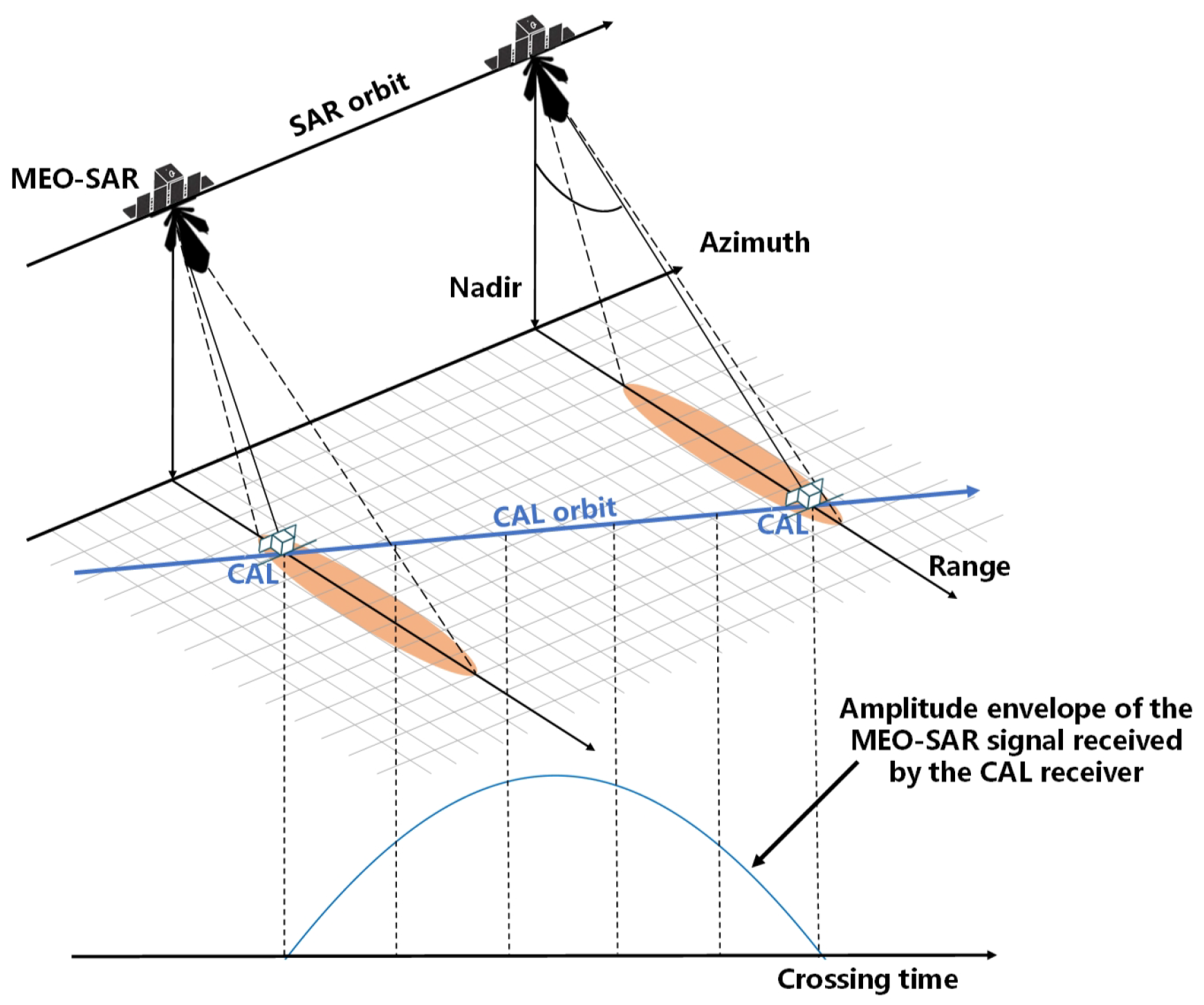
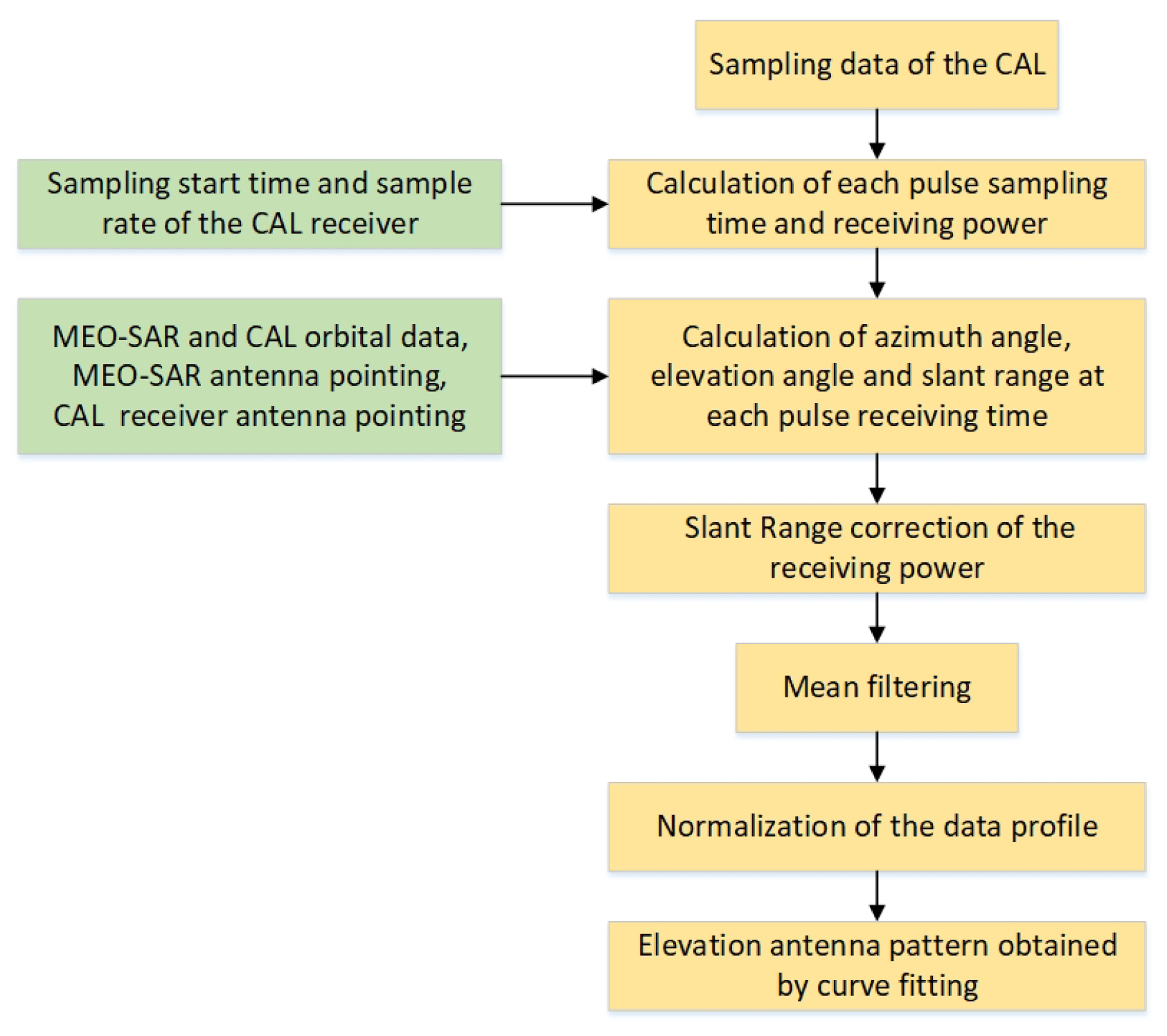
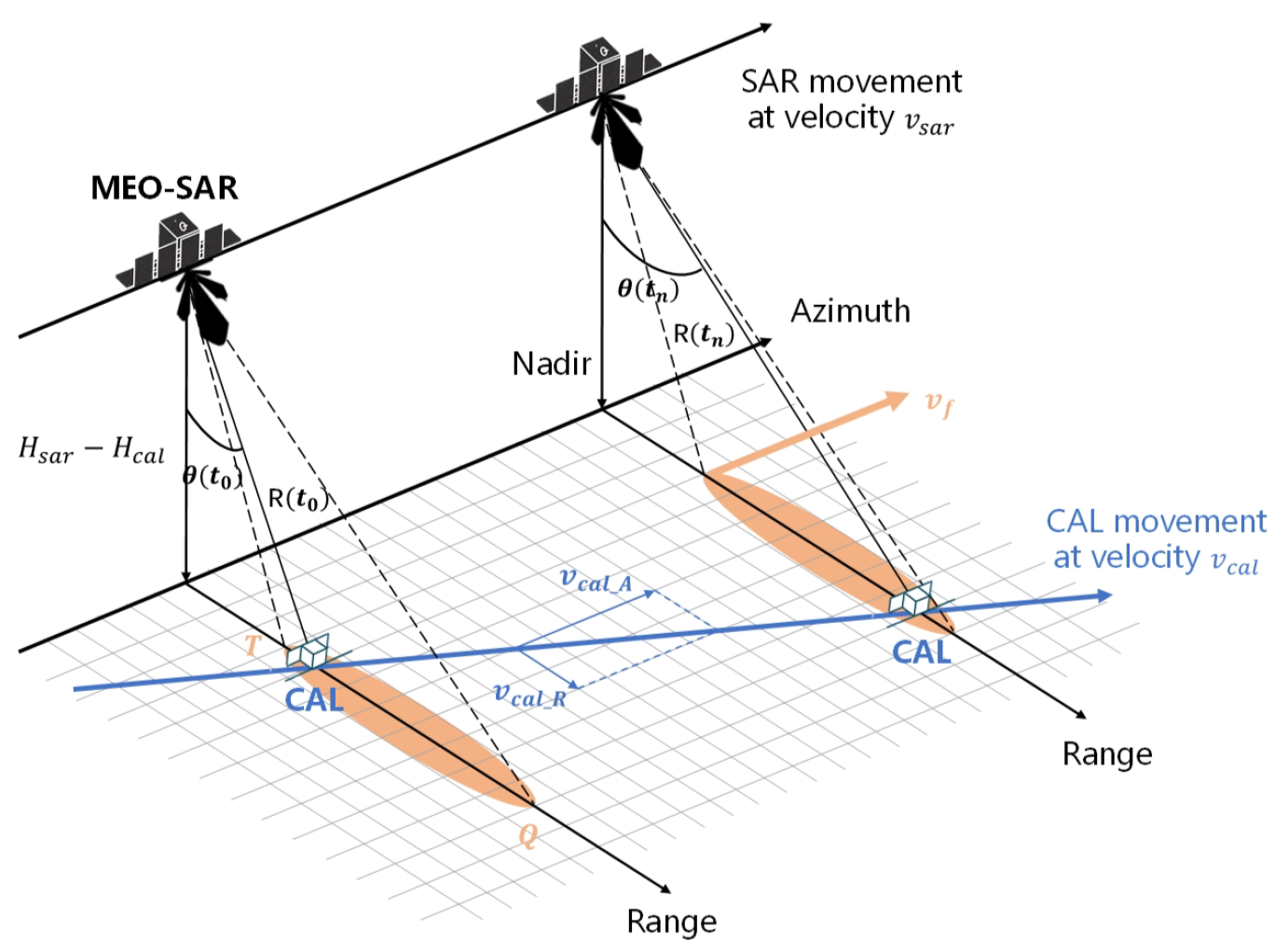
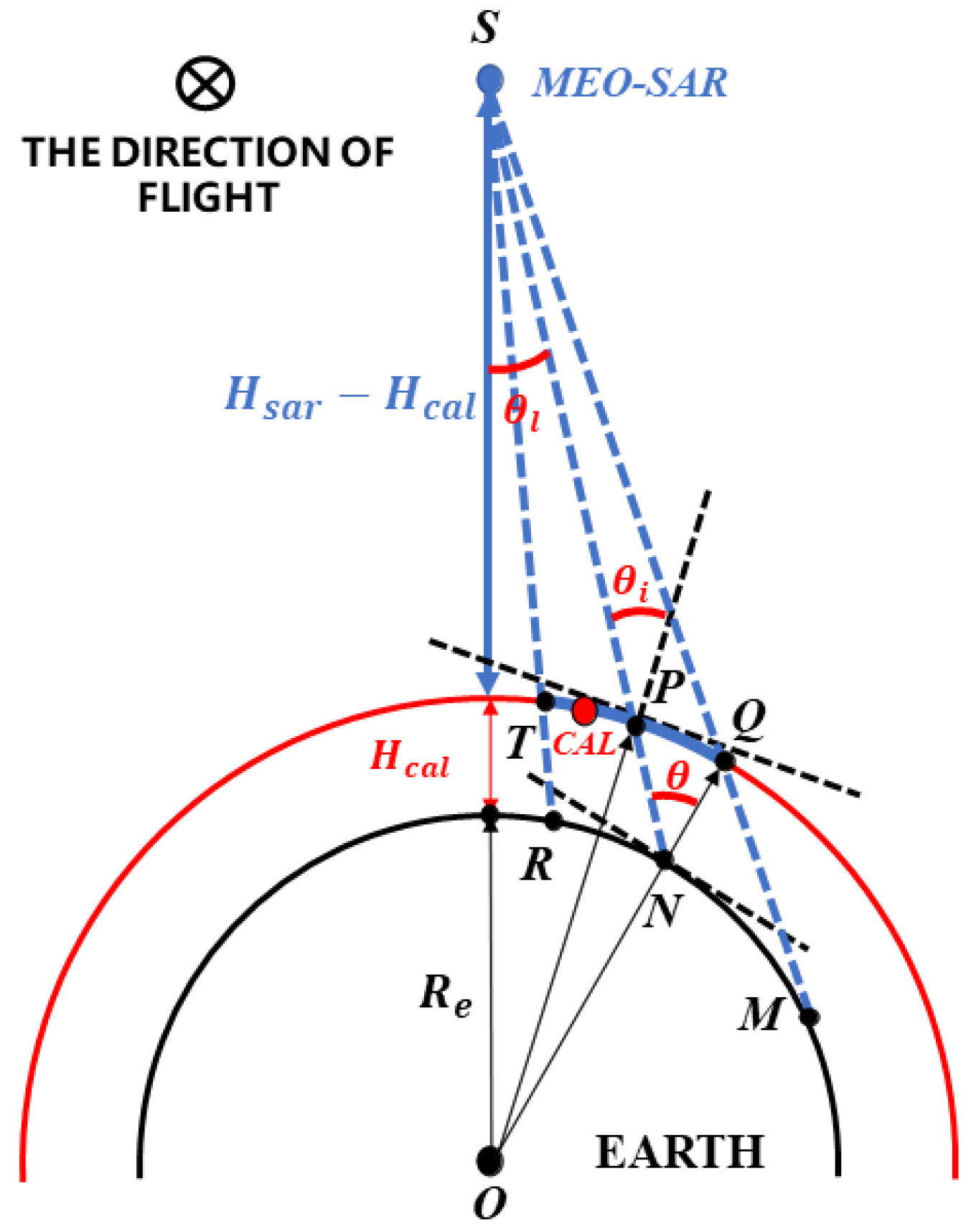
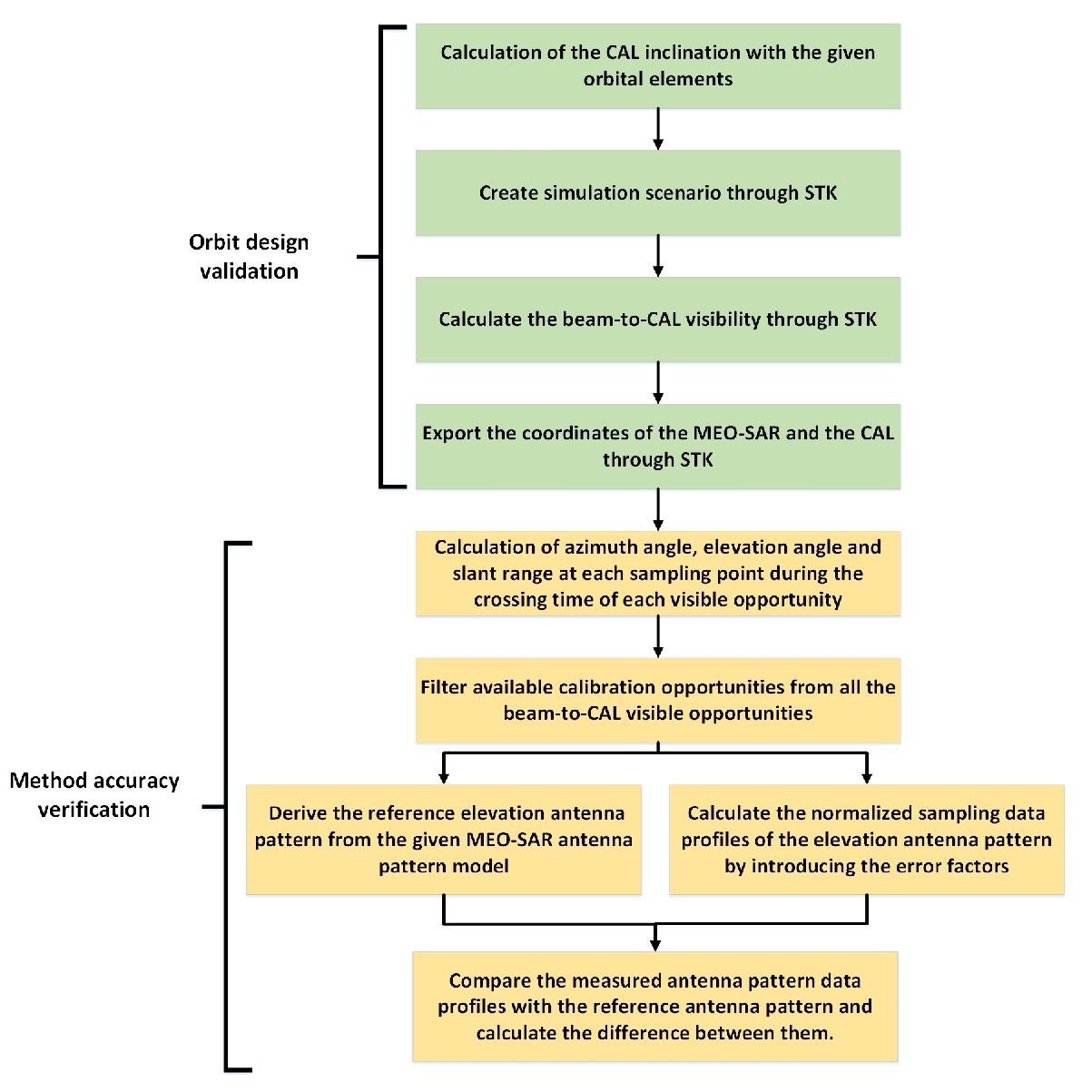
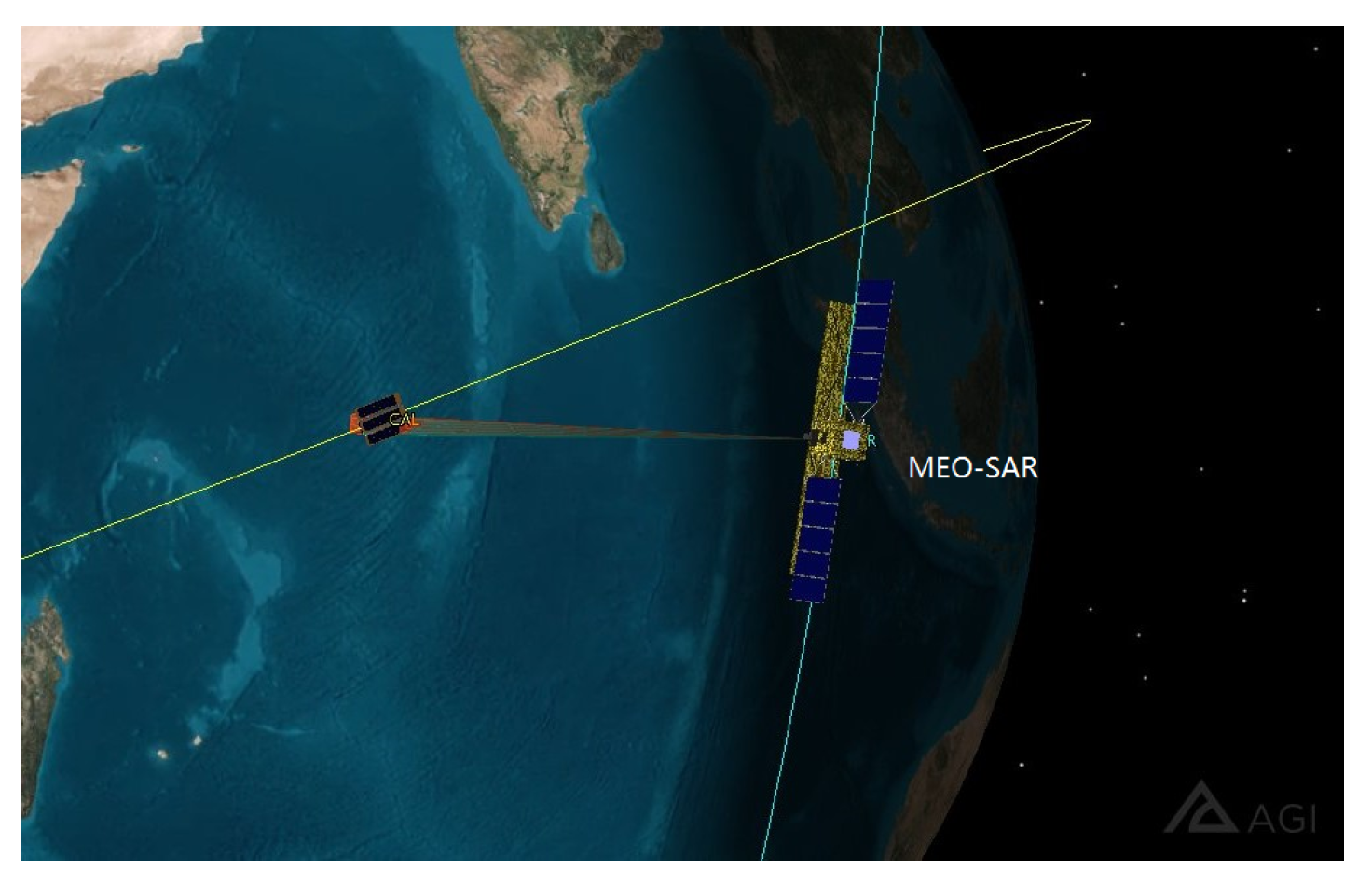

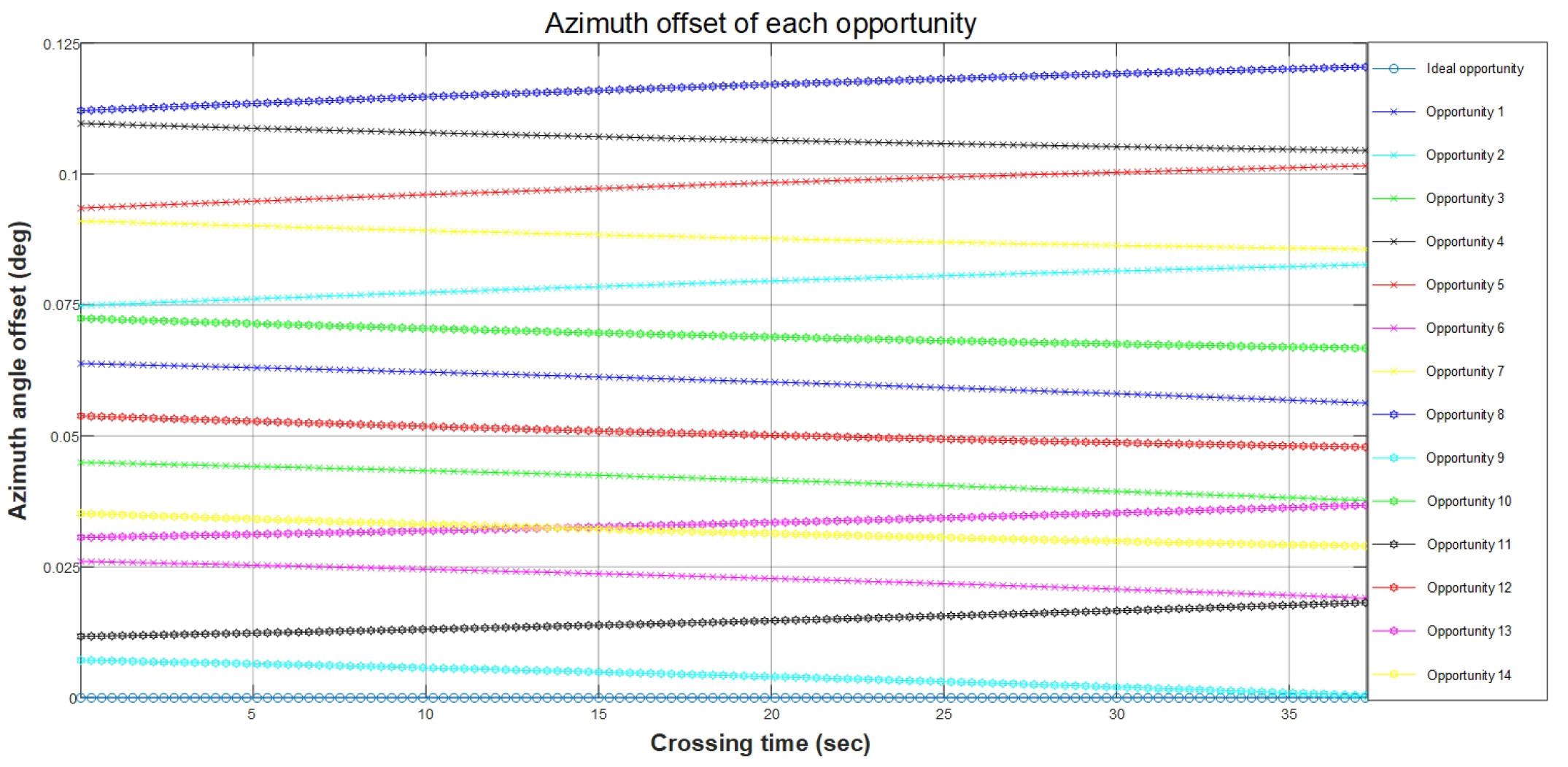
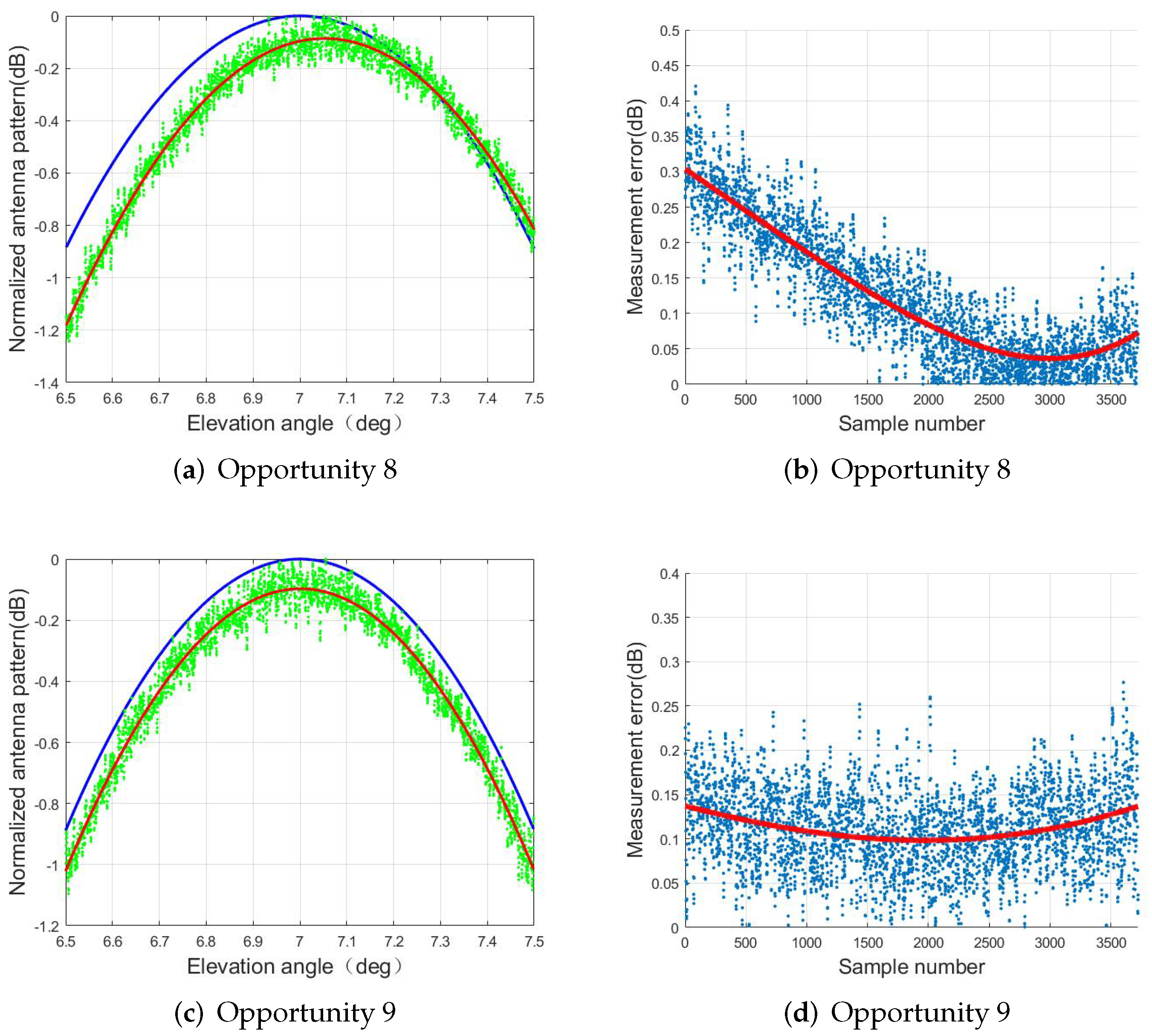
| MEO-SAR Orbit Parameters | Values |
|---|---|
| Orbit Altitude | 15,000 km |
| Semimajor Axis | 21,371.393 km |
| Eccentricity | 0 |
| Inclination | 98 deg |
| Radar Parameters | Values |
| Radar Center Frequency | 5.4 GHz |
| 4 m | |
| 0.7 m | |
| Look Direction | R |
| Squint Angle | 0 deg |
| Center Look Angle | 7 deg |
| Azimuth Beam Width | 0.25 deg |
| Range Beam Width | 1 deg |
| Equivalent Isotropically Radiated Power (EIRP) | 45 dBW |
| CAL Receiver Parameters | Values |
| Antenna Gain | 10 dB |
| Receiving Pattern 3 dB Beam Width | 30 deg |
| Error Factors | Values |
|---|---|
| SAR Transmitting Power Stability | 0.3 dB () |
| The Receiver Channel Gain Stability | 0.2 dB () |
| Orbit Determination Accuracy by GPS | 60 m () |
| Three-Axis Attitude Accuracy of the MEO-SAR | 0.01 deg () |
| Three-Axis Attitude Accuracy of the CAL | 0.15 deg () |
| Satellite | Semimajor Axis | Eccentricity | Inclination | Argument of Perigee | RAAN | True Anomaly |
|---|---|---|---|---|---|---|
| MEO-SAR | 21,371.393 km | 0 deg | 98 deg | 270 deg | 88 deg | 0 deg |
| CAL | 7171.393 km | 0 deg | 177.14 deg | 270 deg | 88 deg | 0 deg |
| Opportunities | Start Time (UTCG) | Stop Time (UTCG) | Duration (s) |
|---|---|---|---|
| 1 | 23 November 2021 15:16:50.779 | 23 November 2021 15:17:28.002 | 37.223 |
| 2 | 9 January 2022 22:53:30.453 | 9 January 2022 22:54:07.677 | 37.224 |
| 3 | 24 January 2022 21:27:49.336 | 24 January 2022 21:28:26.557 | 37.221 |
| 4 | 8 February 2022 19:45:49.781 | 8 February 2022 19:46:27.005 | 37.224 |
| 5 | 13 March 2022 05:04:29.005 | 13 March 2022 05:05:06.229 | 37.224 |
| 6 | 28 March 2022 03:38:47.889 | 28 March 2022 03:39:25.110 | 37.221 |
| 7 | 12 April 2022 01:56:48.333 | 12 April 2022 01:57:25.557 | 37.223 |
| 8 | 14 May 2022 11:15:27.557 | 14 May 2022 11:16:04.782 | 37.225 |
| 9 | 29 May 2022 09:49:46.441 | 29 May 2022 09:50:23.663 | 37.221 |
| 10 | 13 June 2022 08:07:46.887 | 13 June 2022 08:08:24.111 | 37.224 |
| 11 | 30 July 2022 16:00:44.994 | 30 July 2022 16:01:22.215 | 37.221 |
| 12 | 14 August 2022 14:18:45.439 | 14 August 2022 14:19:22.662 | 37.223 |
| 13 | 30 September 2022 22:11:43.547 | 30 September 2022 22:12:20.767 | 37.220 |
| 14 | 15 October 2022 20:29:43.991 | 15 October 2022 20:30:21.215 | 37.224 |
| 15 | 8 December 2021 13:35:03.366 | 8 December 2021 13:35:28.451 | 25.085 |
Publisher’s Note: MDPI stays neutral with regard to jurisdictional claims in published maps and institutional affiliations. |
© 2022 by the authors. Licensee MDPI, Basel, Switzerland. This article is an open access article distributed under the terms and conditions of the Creative Commons Attribution (CC BY) license (https://creativecommons.org/licenses/by/4.0/).
Share and Cite
Qiu, T.; Wang, Y.; Hong, J.; Xing, K.; Du, S.; Mu, J. An In-Orbit Measurement Method for Elevation Antenna Pattern of MEO Synthetic Aperture Radar Based on Nano Calibration Satellite. Remote Sens. 2022, 14, 741. https://doi.org/10.3390/rs14030741
Qiu T, Wang Y, Hong J, Xing K, Du S, Mu J. An In-Orbit Measurement Method for Elevation Antenna Pattern of MEO Synthetic Aperture Radar Based on Nano Calibration Satellite. Remote Sensing. 2022; 14(3):741. https://doi.org/10.3390/rs14030741
Chicago/Turabian StyleQiu, Tian, Yu Wang, Jun Hong, Kaichu Xing, Shaoyan Du, and Jingwen Mu. 2022. "An In-Orbit Measurement Method for Elevation Antenna Pattern of MEO Synthetic Aperture Radar Based on Nano Calibration Satellite" Remote Sensing 14, no. 3: 741. https://doi.org/10.3390/rs14030741
APA StyleQiu, T., Wang, Y., Hong, J., Xing, K., Du, S., & Mu, J. (2022). An In-Orbit Measurement Method for Elevation Antenna Pattern of MEO Synthetic Aperture Radar Based on Nano Calibration Satellite. Remote Sensing, 14(3), 741. https://doi.org/10.3390/rs14030741







